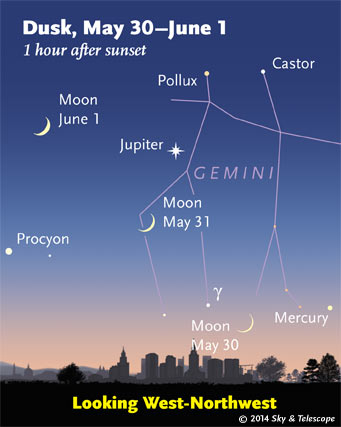
Friday, May 30
Look low in the west-northwest in twilight for the hairline crescent Moon with dim Mercury to its right. They're far down to the lower right of bright Jupiter, as shown here. Binoculars will help.
Comet 209P/LINEAR, the source of the (few) Camelopardalid meteors last week, is barely past its closest to Earth. But it's faint, only about 11th magnitude. If you want to try for it with a moderately large telescope, use our detailed finder charts. (The times and dates there are in Universal Time.) The comet is rapidly heading south; it crosses from Crater into Hydra tonight. UPDATE: By June 2nd it was back down to 13th magnitude.
Saturday, May 31
The Moon, Jupiter, and Pollux above them form a nearly straight line in twilight as seen from North America, as shown here.
Sunday, June 1
At nightfall, Mars shines yellow-orange in the south. Look 4° (two or three finger-widths at arm's length) above it for 3rd-magnitude Porrima (Gamma Virginis). This is a famous, fast-changing close double star for telescopes. This year its two components, equal in brightness, are 2.2 arcseconds apart. A decade ago they were unresolvable.
Monday, June 2
With summer not far off, can you still catch Procyon low in the twilight? It's lower left of Jupiter and, this evening, below or perhaps lower right of the Moon (depending on your latitude). How much later into the season can you follow it? The first day that a star becomes completely invisible in the afterglow of sunset is called its heliacal setting.
Tuesday, June 3
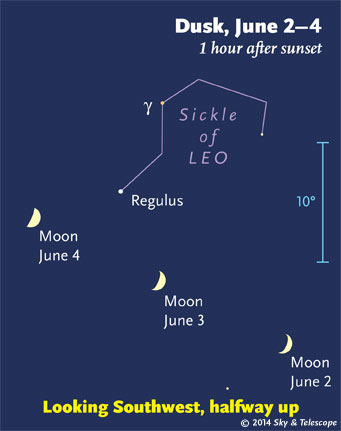
Look above the Moon early this evening for Regulus and Gamma (γ) Leonis, slightly fainter. They're the two brightest stars of the Sickle of Leo.
Wednesday, June 4
As the stars come out, Regulus and the Sickle of Leo are now upper right of the Moon.
Thursday, June 5
First-quarter Moon (exact at 4:39 p.m. EDT). The Moon shines below the hind foot of Leo this evening.
"Cassiopeia" usually means "Cold!" Late fall and winter are when this landmark constellation is high overhead (for mid-northern latitudes), but even on warm June evenings it's lurking low. After dark, look for it down near the north horizon. It's a wide, upright W. The farther north you are, the higher it'll appear. But even as far south as San Diego and Atlanta it's completely above the true horizon.
Friday, June 6
With June under way, the Big Dipper is swinging around after dark to hang down by its handle high in the northwest. The middle star of its handle is Mizar, with tiny little Alcor right next to it. On which side of Mizar should you look for Alcor? As always, on the side toward Vega! Which is now shining in the east-northeast.
Saturday, June 7
The waxing gibbous Moon shines below Mars this evening. Look for Spica to their left.
Want to become a better astronomer? Learn your way around the constellations. They're the key to locating everything fainter and deeper to hunt with binoculars or a telescope.
This is an outdoor nature hobby. For an easy-to-use constellation guide covering the whole evening sky, use the big monthly map in the center of each issue of Sky & Telescope, the essential guide to astronomy. Or download our free Getting Started in Astronomy booklet (which only has bimonthly maps).

Once you get a telescope, to put it to good use you'll need a detailed, large-scale sky atlas (set of charts). The standards are the little Pocket Sky Atlas, which shows stars to magnitude 7.6; the larger and deeper Sky Atlas 2000.0 (stars to magnitude 8.5); and once you know your way around, the even larger Uranometria 2000.0 (stars to magnitude 9.75). And read how to use sky charts with a telescope.
You'll also want a good deep-sky guidebook, such as Sue French's Deep-Sky Wonders collection (which includes its own charts), Sky Atlas 2000.0 Companion by Strong and Sinnott, the bigger Night Sky Observer's Guide by Kepple and Sanner, or the beloved if dated Burnham's Celestial Handbook.
Can a computerized telescope replace charts? Not for beginners, I don't think, and not on mounts and tripods that are less than top-quality mechanically (able to point with better than 0.2° repeatability, which means fairly heavy and expensive). As Terence Dickinson and Alan Dyer say in their Backyard Astronomer's Guide, "A full appreciation of the universe cannot come without developing the skills to find things in the sky and understanding how the sky works. This knowledge comes only by spending time under the stars with star maps in hand."
This Week's Planet Roundup
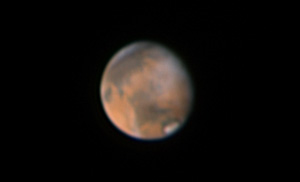
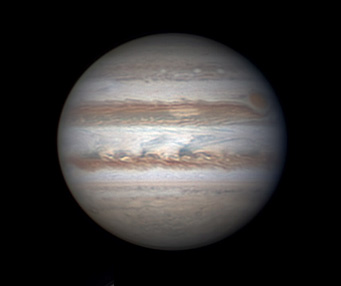
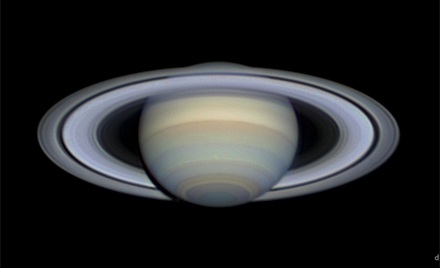
Venus (magnitude –3.9) is quite low in the east during dawn.
Mars (magnitude –0.4, in Virgo) shines high in the south in late twilight. Just to its upper left is 3rd-magnitude Gamma Virginis (Porrima). Farther lower left of Mars sparkles Spica. Mars sets in the west around 2 or 3 a.m. daylight saving time.
In a telescope, Mars's gibbous disk is about 11.5 arcseconds tall and shrinking. See the Mars map and observing guide in the March Sky & Telescope, page 50. Use our Mars Profiler to find which side of the planet will be facing Earth when you plan to look.
Jupiter (magnitude –1.9, in Gemini) shines brightly in the west in twilight, with Pollux and Castor to its upper right. It sets fairly soon after dark.
Saturn (magnitude +0.2, in Libra) shines in the southeast during evening and stands highest in the south around 11 or midnight. The wide binocular double star Alpha Librae glimmers to its lower right early in the evening, and directly right later; they're about 4° apart, fitting within a typical binocular's field of view.
Look for Antares and the head of Scorpius well to Saturn's lower left.
It a telescope Saturn's globe is 19″ wide, and its rings are tilted a nice 22° from our line of sight. Use our SaturnMoons app to find and identify Saturn's various satellites at any time and date. A 6-inch scope will show four or five of them fairly easily: Titan, Rhea, Dione, Tethys, and Iapetus.
Uranus, in Pisces, is low in the east just before dawn begins.
Neptune, in Aquarius, is up in the southeast before the first light of dawn. Use our finder charts for Uranus and Neptune in 2014.
----------------------------------
“This adventure is made possible by generations of searchers strictly adhering to a simple set of rules. Test ideas by experiments and observations. Build on those ideas that pass the test. Reject the ones that fail. Follow the evidence wherever it leads, and question everything. Accept these terms, and the cosmos is yours.”
— Neil deGrasse Tyson, 2014. The final episode of the Cosmos series airs this Sunday night (June 1) on Fox, and Monday (June 2) on National Geographic. Watch recent episodes online anytime.
All descriptions that relate to your horizon — including the words up, down, right, and left — are written for the world's mid-northern latitudes. Descriptions that also depend on longitude (mainly Moon positions) are for North America.
Eastern Daylight Time (EDT) is Universal Time (UT, UTC, or GMT) minus 4 hours.
 0
0
Comments
You must be logged in to post a comment.